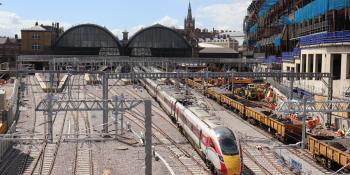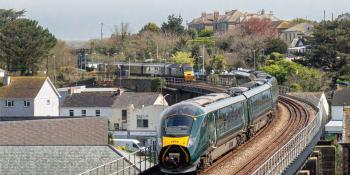
All 1,247 Class 800-803 vehicles are to have fatigue cracks in their yaw damper brackets repaired at Arlington Fleet Services, Eastleigh, in a programme which is expected to run until 2028.
This follows the separate discovery last spring of cracks in both the yaw dampers and the lifting plates on Hitachi-built ‘80x’ trains. The latter caused all such trains to be temporarily withdrawn from service, before an inspection regime enabled them to be reintroduced. The Office of Rail and Road has now released its report, which it undertook after the mass withdrawal from service.
The issues with the yaw dampers were caused by fatigue cracking. Greater loads than expected from train movement than allowed for in the original design caused the fatigue cracks – but it is still unclear why this happened. Investigations continue into the effects of wheel wear and track design (including rail head profile and rail roughness) on the trains.
Issues with the lifting plates were caused by stress corrosion cracking, which ORR attributes to the presence of 7000 Grade aluminium. It says this is particularly vulnerable to the impact of chlorides, which are particularly prominent in the UK climate.
A further 487 Class 385 and 395 vehicles are also to be repaired after the discovery of cracks in those fleets.
Hitachi plans to replace the affected parts of the original body structures to address the yaw damper fatigue cracks issue (as previously reported in Modern Railways), including the longitudinal welds where the cracks occurred as well as the mounting brackets. The train builder is to add bolts to retain the lifting pockets should cracks occur, although in a briefing to journalists ORR emphasised that it does not believe there is a safety risk relating to the plates detaching in service.
However, while the report identifies the causes of the cracks and remedial action to be undertaken, it confirms that Hitachi built the trains to the relevant standards and that the company acted swiftly and appropriately to ensure the safety of the trains and maintain availability of them to operators.
The ORR’s report makes recommendations about further investigations to identify the causes of higher levels of fatigue loading, and whether the relevant industry standards take into account the loads arising from operation on the UK rail network. It says Hitachi Rail should carry out a formal review of the effectiveness of its welding processes when component geometry is more challenging, and that designers of rolling stock should understand the risk of stress corrosion cracking when proposing to use 7000 series aluminium components.
The final two recommendations are that the rail industry should consider whether a standard for mitigating SCC risk should be developed, and that it should develop a process for responding to similar future cross-industry crisis events and appoint a strong, independent chair ‘who can maintain pace, focus and ensure all voices are heard’.



